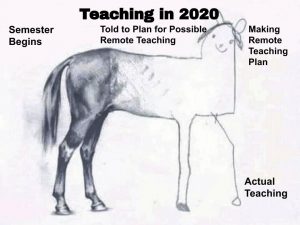
Let this not be you …Keep it Simple!
Photo Credit: Creative Commons
- Experimental Journaling: Creating Documents for Future Historians on the Coronavirus (courtesy of Peter Pozefsky, History)
- Media Engagement Under Social Distancing (courtesy of Nii Nikoi, Global Media & Digital Studies)
- Modeling the Spread of the Virus (courtesy of Jillian Morrison, Mathematics)
- Human Stress & Society (courtesy of Ashley Abraham, Psychology & Neuroscience)
- Have students read an article about how avoiding large gatherings helps to reduce infection rates (such as Eliza Barclay & Dylan Scott’s “How Canceled Events and Self-Quarantines Save Lives, in One Chart.” Vox, March 10, 2020). Ask them to reflect on how their move online connects to concepts in your class. For instance, how is it a morally, ethically, medically, and/or socially responsible decision?
- If you haven’t already, ask students to complete mid-semester course evaluations reflecting on things that were working well to promote learning previously, and those that weren’t. Use this info to inform what types of assignments you consider for remote learning. You can find templates to collect them here.
- Spread the load. Connect with colleagues from other institutions to organize a guest lecture (and/or assignment) exchange. Introduce your students to their research areas. Dust off a research talk, set of class notes on a topic you already know well and connect with each other’s students.
- Ask students to collaborate in small groups to participate in redesigning the syllabus (via shared documents, which they can do via Word through OneDrive or on GoogleDocs). What ideas do they have for tweaking the course in the next few weeks (or longer) that meet with your central goals for the course?
- Consider communicating with students as a “correspondence course” of sorts. Email questions or assignments, ask students either to email back (though this will generate a LOT of email for a large class) or communicate through Moodle & have them turn in assignments there.
- Send the link to a video or audio option related in your course material in lieu of a reading (or two). Ask for a response either written to you in an email or attached as a brief video-recording.
